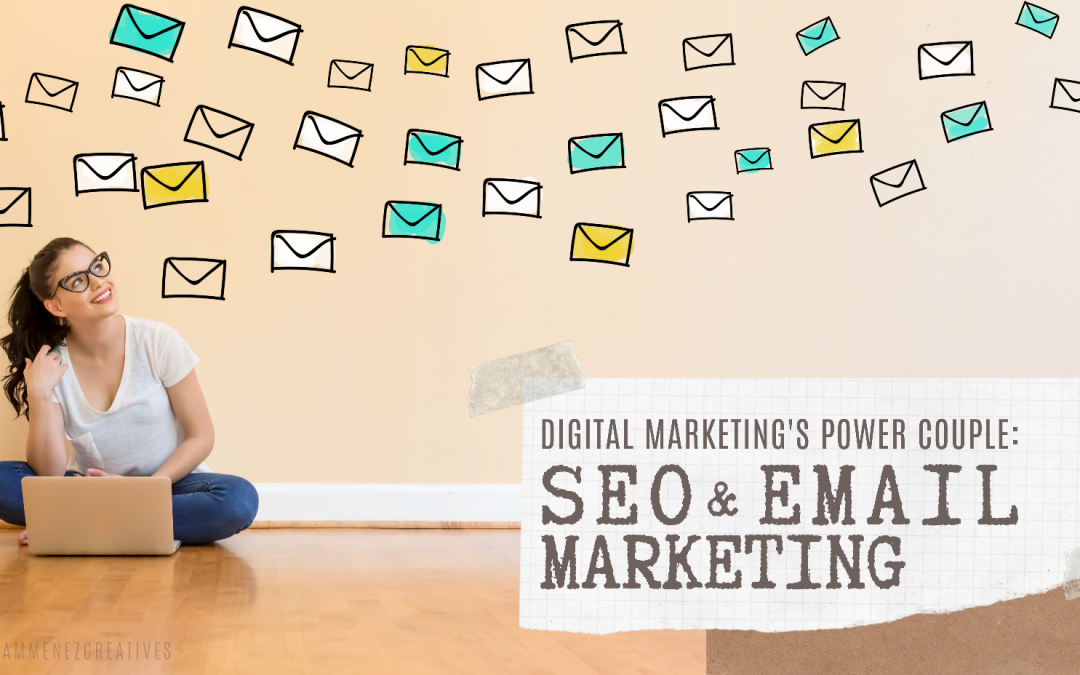If you want to see significantly profitable results from your SEO strategies, then start marrying your email marketing campaigns with those strategies. SEO-friendly content and email marketing go together like the perfect, power couple. Aligning your marketing plan with both strategies integrated saves you time, drives results, and enhances your lead-nurturing and sales funnel.
Aiming beyond one-hit wonders or irregular spikes in building prospects, organic SEO proves useful in long-term lead-generation by helping people to discover your website through their search intent. Adding Email Marketing brings you to the next level in generating, following up, and nurturing those leads.
Both methods drive people to a website and leading them to convert. If they have the same end goal, why do most digital marketers use them separately?
Whatever is written in SEO can and should be echoed within emails and on-site content. In the same way, newsletters can bring traffic to your website and increase your SEO rankings. It’s time to start optimising your newsletters with SEO in mind and doing SEO strategies side-by-side with email marketing. Here are some ways you can do both successfully to increase ROI for all your marketing campaign as a whole:
Keywords and phrases need to be aligned in both SEO and Emails
On-site content needs to be SEO-friendly, readable, and navigable so, targeting keywords and phrases that fit your target niche’s search queries to rank highly in Google’s Search Engine Results Page (SERP).
Make it a standard to produce high-quality content, using these keywords and phrases seamlessly in the things you write, including titles, alt tags, and meta descriptions. In the same way, this practice should also be followed as you write your newsletters—create beautiful newsletters in a simple, readable layout using relevant industry-related keywords in your content and titles.
Choose long-tail keywords that are more descriptive and drive traffic from a more concise, targeted market niche. Google notes that it takes an average of 10.4 pieces of content before an online customer comes down to a purchasing decision. This cycle is known as the Zero Moment of Truth (ZMOT). For instance, the consumer found your PPC ad online. He clicks your ad and visits your site. The second piece of content he might consume is by researching some results on Google’s SERP regarding the product or service advertised in your PPC ad. The third round of content he might see is an email you sent him when he left his contact information on your landing page or contact page. Because he has done prior research, the chances are high that he will finally come to a purchase decision on the product or service you advertised.
Email marketing conversion rate is still one of the most profitable among digital marketing strategies, as it currently brings, on the average, 23.4% open rate and 17.8% click-through rate, and an impressive 41.85% conversion rate.
Track the impact of your digital marketing efforts through UTM parameters to email links
Urchin Tracking Module (UTM), used to be “a web analytics software, developed by Urchin Software Corporation and designed to track the behaviour of unique website visitors.” In 2005, Google acquired this company, which helped them develop Google Analytics. Today, UTM is an analytics tool used by marketers to “track the impact of their online marketing efforts, better understand their audience’s behaviour, and measure performance.” With UTM tags, you can find which channels bring the most sales conversions to your site.
It uses tags (modules or variables) that you add to the end of a link, to track and analyse the sources of page traffic. The parameters of link clicks are sent back to Google Analytics, appearing in different analytics dashboards.
UTM allows you to monitor what emails bring you the most traffic, and track improvements monthly and see the type of email marketing campaign that works best for your SEO campaign. You can add UTM parameters through Google’s Dev Tools and track them through Google Analytics.
Upcycle your newsletters by developing them into blog content
You can extend the life of your newsletters, especially the ones that brought the highest traffic to your site, by converting them into blog content for your website or your social media accounts to tie in with your social media marketing strategies. The actionable content that brought you success in your email marketing strategies can also bring success in your SEO if you repurpose the content.
Your email campaign will have a positive impact on your website’s rankings when Google indexes that content. In repurposing longer newsletters, you can use the same material and use relevant links. For shorter newsletters, you can group recurring themes in one blog post.
You can get more email subscribers this way when readers on your website or social media accounts see what they are missing. It is a winning scenario for both your SEO and email marketing strategies, and all you did was upcycle used content, giving them a new lease of life.
Add canonical tags as you archive emails.
It is important to archive your older content if you are running newsletters and email campaign strategies regularly and add canonical tags. When you canonicalize a URL, it tells search engine crawlers which URL should be indexed when there are multiple pages with similar content. You avoid getting penalized that can affect your SERP ranking, and you also gain new subscribers.
You need to update your archives every time you send out another issue by adding a canonical tag to your newsletters that points towards your blog page, telling Google which preferred URL you want it to index. To canonicalize your content, simply insert the canonical tag into the <head> of your newsletter archive page, with the link to your blog page. It prevents your archive page and blog page from getting mixed up due to the similarities in content.
Encourage engagement through social shares and linkbacks
Your goal should go beyond a single click-through to your site. You need to consider how you can nurture your click-through leads and encourage further engagement, increasing linkbacks to your site.
You can include links in your email marketing offers, or include actionable pieces of information that can increase backlinking. The results of your email marketing may not directly land you on SERP. Still, if you are strategically releasing newsletters with the intent to lead people to your website, you can use emails as a launching pad for backlinks. Include compelling CTAs (Call-to-Action) that encourage engagement, like asking your email subscribers to leave a comment in your blog, or have social share buttons on your newsletter.
If you have bloggers on your subscription list, producing high-quality content is all the more crucial, as they can potentially include inbound links back to your site or share your content on their social media accounts. All this organic activity from your email campaign does well for your SEO rankings.
Build and maintain a highly-engaged email list
Develop an active, highly-engaged email list of contacts. Identify recipients actively opening emails, reading your content, and clicking through to your website. These subscribers will likely be interested in searching for more content on your website. Email marketing tools are available to measure audience engagement, and some provide the option to automize metrics to appear on dashboards immediately after an email blast.
Study your audience and learn about their preferences. Use your content both in email marketing and SEO. “If you have a really good, highly engaged email audience, you know a lot already about the kinds of people you’re trying to attract. Using that content to make your brand into a magnet is a really good way to make those two things—[email marketing and SEO]—kind of dovetail together,” said Deb Gabor, CEO of brand strategy consultancy Sol Marketing.
Create emails with top-of-mind awareness.
If your newsletter added value to your audience, if it was engaging resonates well in their minds, they’ll naturally search for that content again in the future. For instance, if you go to a supermarket looking for soup, Campbell’s is a top-of-mind brand in that category. Gabor added that “you’ll remember to search content from an email like you remember to search for Campbell’s soup in a supermarket.”
Don’t just blast your audience with emails repeatedly as spammers do. Instead, integrate email marketing in your overall marketing strategy to help build your website as a top-of-mind brand. Go beyond emails and build this awareness also through other content such as blogs, videos, and social media. Email marketing should come in support of your SEO content.
Use marketing automation tools can help you take customers on a multi-channel journey and measure your campaign’s results. It may take extra work on your part, but increasing brand awareness is worth it. It’s easier to convince people to convert if they are already aware of you and your brand.
Conclusion: SEO and Email Marketing, A Perfect Match
Email marketing is a way of connecting high-quality visitors with your high-quality content. SERP algorithms are ever-improving at separating quality content from the rest. A good SEO strategy, then, aims to put out good content, while email marketing puts your best content in front of the best audience possible. Your email efforts should complement, not compete, with your SEO goals. So, may your SEO and email marketing strategies have more fruitful, harmonious years together, and birth the most profit margins to your digital marketing campaigns.
AUTHOR’S BIO

Mayleen Meñez
Mayleen Meñez worked in media for almost seven years in TV, radio, and post-production as a Graphic Artist/Editor. Finding her true passion for NGO and community development work, she devoted 15 years as a coordinator and teacher, traveling both in the Philippines and countries in Asia. She homeschools her three kids and reinvents Filipino dishes in her spare time. Writing has always been a hobby and pursuit, and she recently added content writing with Softvire Australia and Software New Zealand up her sleeve, while preparing for her next adventure in the nations.



